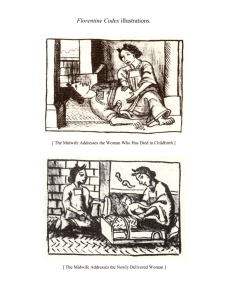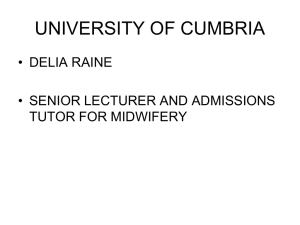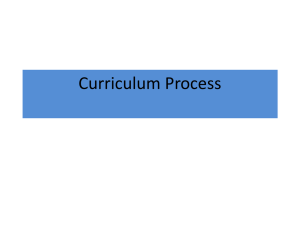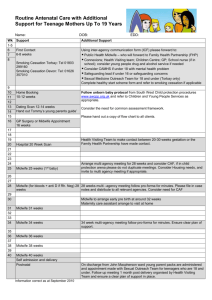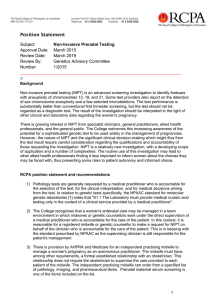Powerpoint
advertisement
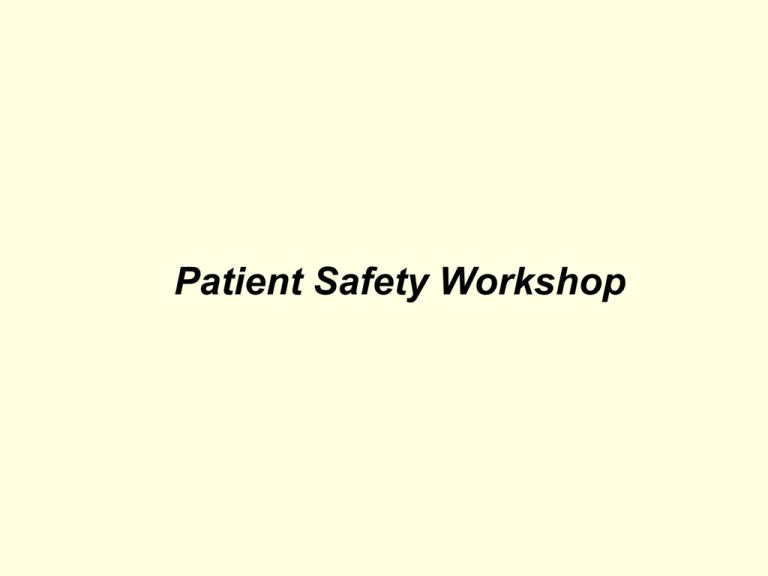
Patient Safety Workshop Introductions • Students • Tutors Teaching Methods • • • • DVD story about a real care pathway Small group, Interactive and reflective PBL Develop a personal tool for safe practice • Tutors resource Aim To develop competence in patient safety and a life long reflective approach to practice which prioritises patient safety in all aspects of your practice Learning Outcomes By the end of the workshop you will be able to evaluate the importance of: – Effective communication – Situational Awareness – Leadership – Empowerment For ensuring safe practice Outline of the Day • Group ground rules linked to team working • Video scenes and analysis • Situational awareness – coffee • Leadership – lunch • Empowerment • Communication • Evaluation Ground Rules • Introductions • Group Poster What sort of a team do you want to work in? Consider elements of safety Extent of the problem • Complete the quiz Mildred’s Story http://www.youtube.com/watch?v=BTpnPoSyuJg Situational Awareness Analyse the first scenes Look for factors in the situation which contribute to problems How are the people portrayed responding? What are the consequences? Situational Awareness Group discussion: • What concerns you What could you do in a similar situation? As individuals? As a team? • Reflections on your own practice • What can a team do to ensure safe and effective practice? • What examples of safe practice have you seen? Situational Awareness • Environment – Innate ability to protect ourselves – Heightened sense of awareness – Observational skills • Outside of self focus • Personal – Intuitive – Psychological – Physiological Leadership In this section you see various people in leadership roles What types of behaviour do you observe? What is the effect? Why? Behaviour types Submissive Low self esteem Silent, unhelpful, passive try to please, avoid conflict Aggressive Low respect for others Patronising, curt, and aggressive in manner, put people down Passive-aggressive (indirectly aggressive) Low respect for self and others Hints Sarcasm Non-verbal at odds with verbal communication Not taking responsibility for own behaviour Not honest about feelings Assertive High self esteem Respect for others State your point calmly Open Accept not always right and others may not be also Leadership What makes a good leader? What type of leadership do you find most effective? What type of leader do you intend to be? What examples of good leaders have you observed? Empowerment In this section you will see situations in which there are different opinions about the decisions being taken Empowerment What might you do if you see practice that you feel is unsafe? What would be your responsibility as a student? What would your responsibility be as a qualified professional? How far can a junior professional challenge practice? Reporting mistakes “We can only recognise problems if everyone working in the health service is diligent about reporting patient safety incidents to their local organisation or to the NPSA”. Sir John Lilleyman. Group Task Poster professional conduct • Can you outline the main points of your codes of conduct and professional accountability? • Can you outline their similarities and differences Nursing Code • • • • • Respect the patient or client as an individual Obtain consent before you give any treatment or care Protect confidential information Co-operate with others in the team Maintain you professional knowledge and competence • Be trustworthy • Act to identify and minimise risk to patients and clients Midwifery (EXTRACT) Rule 6 Responsibility and sphere of practice A practising midwife is responsible for providing midwifery care, in accordance with such standards as the Council may specify from time to time to a woman and baby during the antenatal, intrapartum and postnatal periods. Except in an emergency, a practising midwife shall not provide any care to undertake any treatment which she has not been trained to give. In an emergency, or where a deviation from the norm which is outside her current sphere of practice become apparent in a woman and baby during the antenatal, intrapartum and postnatal periods, a practising midwife shall call such qualified health professional as may reasonably be expected to have the necessary skills and experience to assist her in the provision of care. Standard A midwife: Cannot arrange for anyone to act as a substitute, other than another practising midwife or a registered medical practitioner. Rule 9 A practising midwife shall keep as contemporaneously as is reasonable continuous and detailed records of observations made, care given, and medicine and any form of pain relief administered by her to a woman or baby. Styles, M., 2008. The STORK study. Midwives’ intrapartum decision-making. PhD thesis. The University of Stirling. Available under a Creative Commons Attribution-Non-Commercial-Sharealike 1.0 licence. (URL: http://dspacedev.stir.ac.uk/handle/1893/1025) Hpc Standards of Performance, Conduct and Ethics SLTs, ODPs, audiologists (voluntary registration) 16 points under 3 headings – Summary High Standards of conduct e.g. – Always act in best interests of clients – Respect confidentiality – High standards of personal conduct High standards of performance e.g. – – – – Maintain knowledge and skills Act within your limits Get informed consent Keep accurate records High standards of ethics e.g. – Behave with honesty and integrity – Don’t damage the reputation of the profession hpc Standards of Proficiency SLTs, ODPs, audiologists (voluntary registration) Headings • Professional autonomy and accountability • Professional relationships • Identification and assessment of health and social care needs • Formulation and delivery of plans and strategies for meeting health and social care needs • Critical evaluation of the impact of or response to the registrants actions Medical Professions’ Code • Abuse of privileges and opportunities afforded to him or any grave dereliction of professional duty or serious breach of medical ethics • Areas of professional conduct or personal behaviour – – – – – Neglect of professional duties Abuse of professional privileges Personal behaviour (conduct derogatory of…..) The advertising of doctors services Disparagement of professional colleagues Key responsibilities of a pharmacist Pharmaceutical Society of Great Britain • Ensure that their knowledge is used for the well-being and safety of patients and members of the public • Provide the best possible health care for the community in partnership with other health professionals • Treat people who seek advice with courtesy, respect and maintain confidentiality • Respect patients’ rights to participate in decisions about their care and must provide information in a way in which it can be understood • Ensure that their knowledge is of high qualty evidence based, and relevant to their field of practice • Behave with integrity and probity, adhere to accepted standards of personal and professional conduct that would not undermine public confidence and trust Communication • Throughout the DVD what examples do you see of: – excellent communication? – poor communication? • Consider solutions to poor communication Communication • The importance of the written word – Court cases The swiss cheese model • See: Reason J. Human error: models and management. Bmj. 2000;320(7237):768. Root course analysis tool NPSA • Have a go? Final thoughts • Seven Steps to Patient Safety NPSA – – – – Build a safe culture Lead and support your staff Integrate your risk management activity Involve and communicate with patients and the public – Promote reporting – Learn and share safety lessons – Implement solutions to prevent harm
